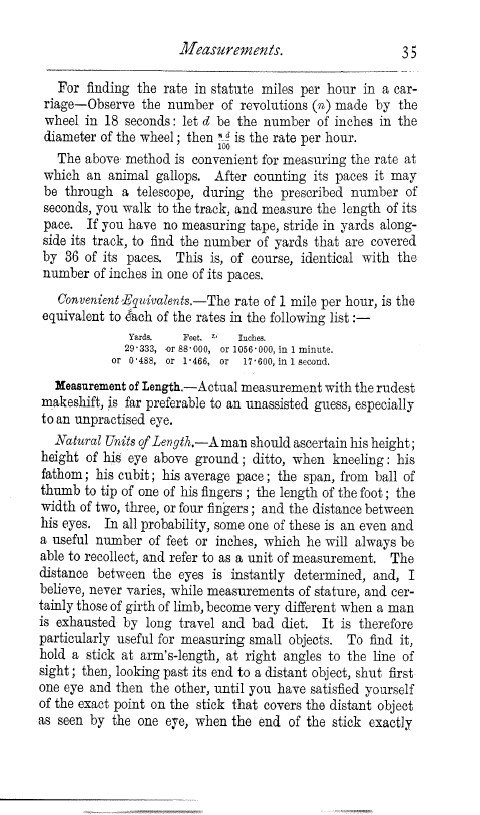Measurements. 3 5
For finding the rate in statute miles per hour in a carriage-Observe the number of revolutions (n) made by the wheel in 18 seconds : let d be the number of inches in the diameter of the wheel ; then ' is the rate per hour.
160
The above method is convenient for measuring the rate at which an animal gallops. After counting its paces it may be through a telescope, during the prescribed number of seconds, you walk to the track, and measure the length of its pace. If you have no measuring tape, stride in yards alongside its track, to find the number of yards that are covered by 36 of its paces. This is, of course, identical with the number of inches in one of its paces.
Convenient Equivalents.-The rate of 1 mile per hour, is the equivalent to each of the rates in the following list:
Yards. Feet. =' Iuches.
29.333, or 88.000, or 1056'000, in 1 minute. or 0.488, or 1.466, or 17.600, in 1 second.
Measurement of Length.-Actual measurement with the rudest makeshift, is far preferable to an unassisted guess, especially to an nn practised eye.
Natural Units of Length.-A man should ascertain his height; height of his eye above ground; ditto, when kneeling: his fathom ; his cubit ; his average pace ; the span, from ball of thumb to tip of one of his fingers ; the length of the foot ; the width of two, three, or four fingers ; and the distance between his eyes. Tn all probability, some one of these is an even and a useful number of feet or inches, which he will always be able to recollect, and refer to as a unit of measurement. The distance between the eyes is instantly determined, and, I believe, never varies, while measurements of stature, and certainly those of girth of limb, become very different when a man is exhausted by long travel and bad diet. It is therefore particularly useful for measuring small objects. To find it, hold a stick at arm's-length, at right angles to the line of sight; then, looking past its end to a distant object, shut first one eye and then the other, until you have satisfied yourself of the exact point on the stick that covers the distant object as seen by the one eye, when the end of the stick exactly

